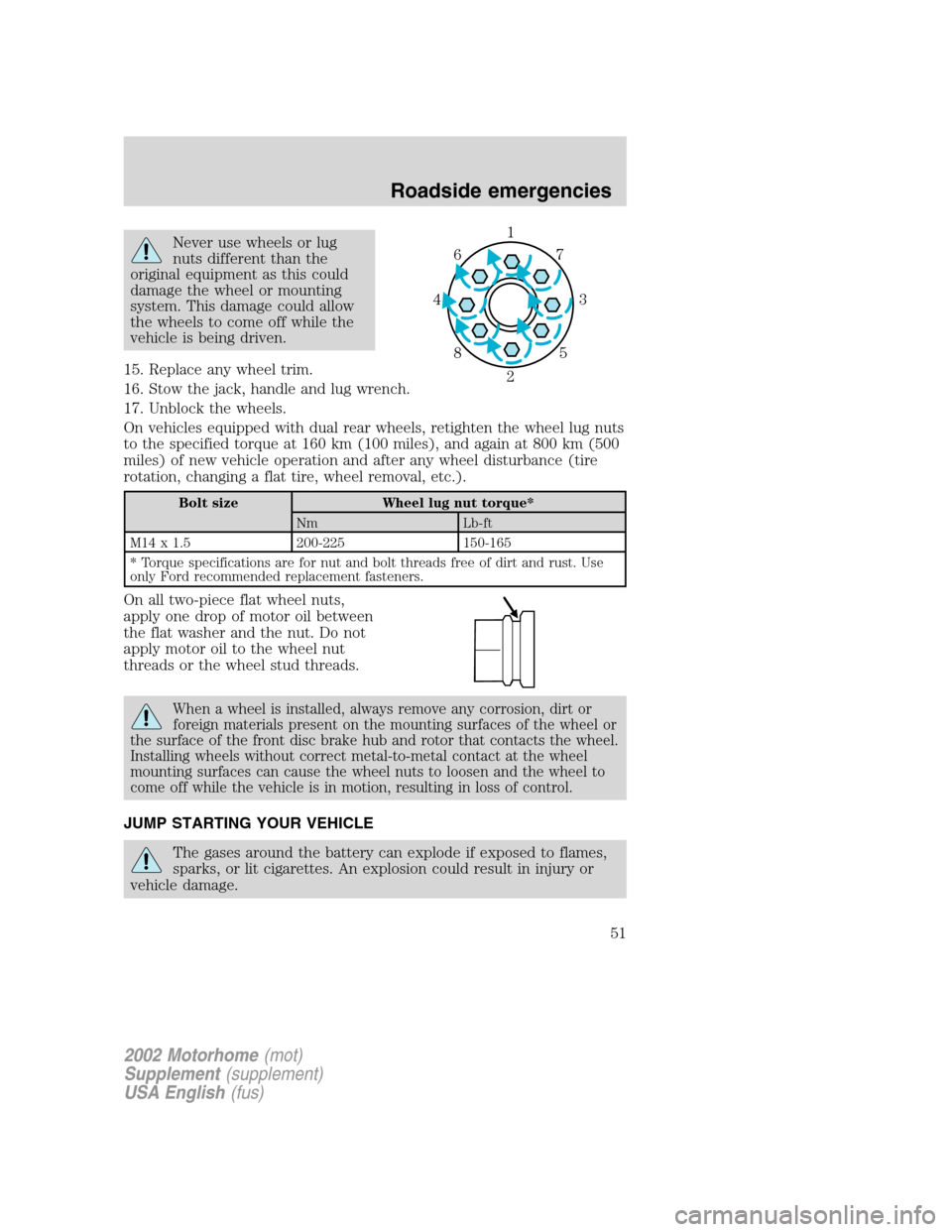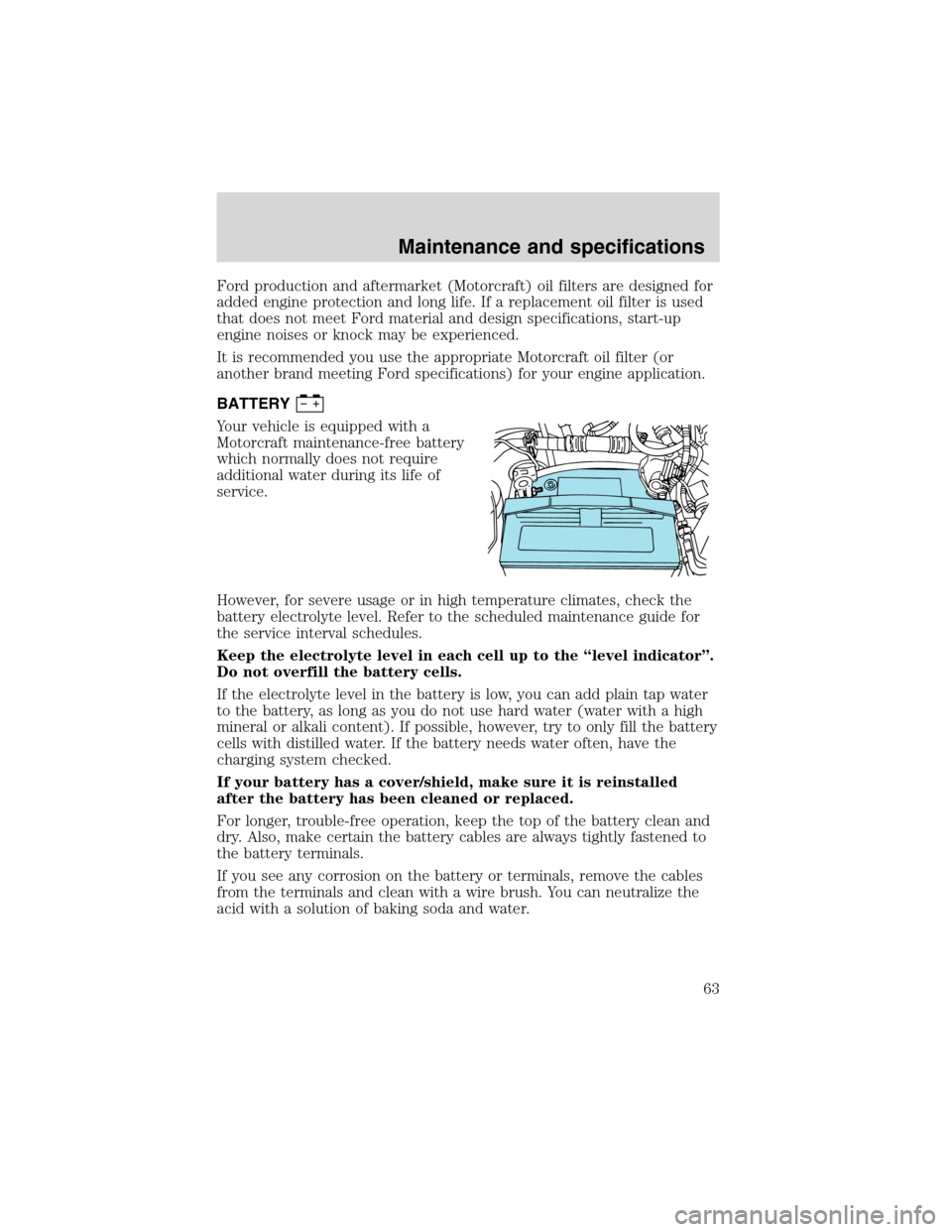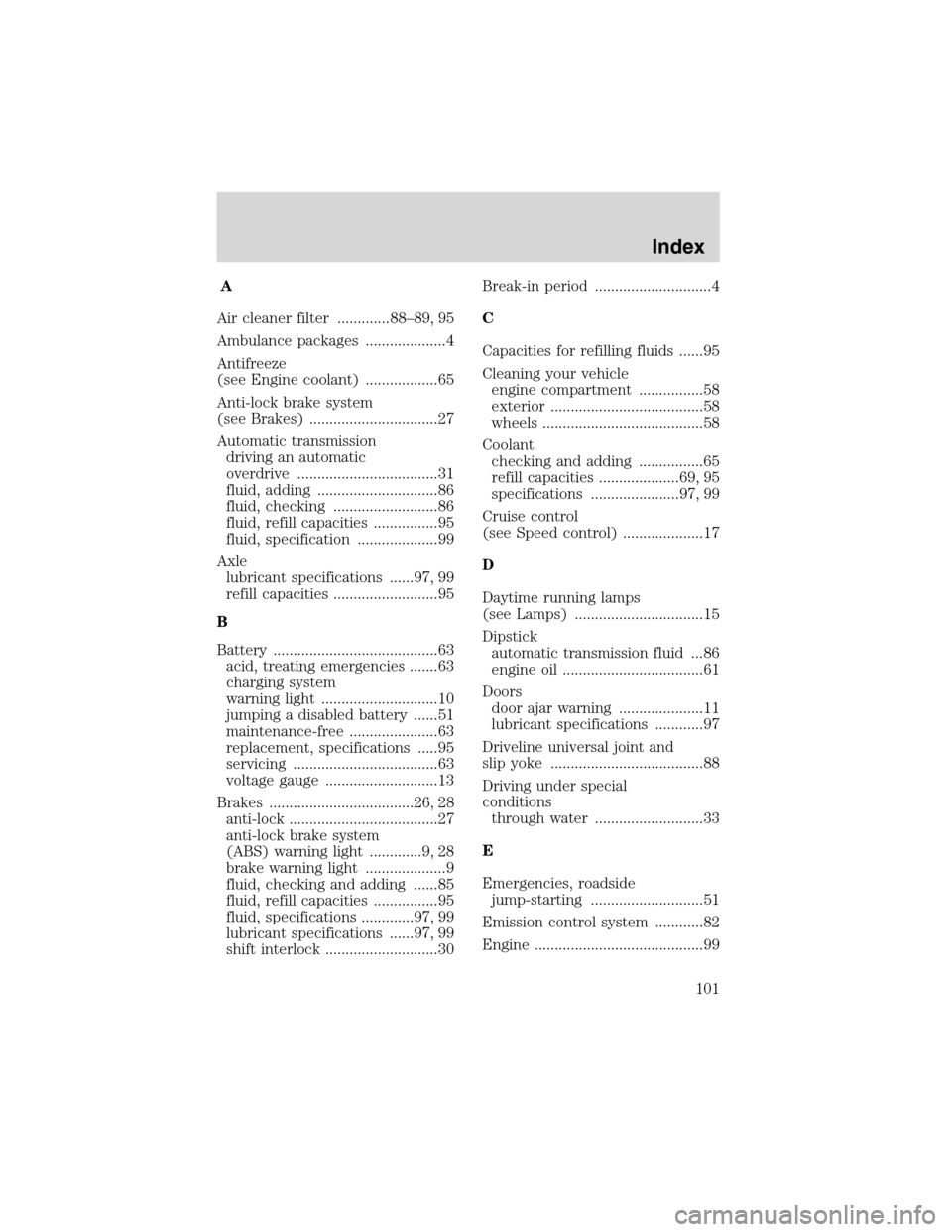Page 51 of 104

Never use wheels or lug
nuts different than the
original equipment as this could
damage the wheel or mounting
system. This damage could allow
the wheels to come off while the
vehicle is being driven.
15. Replace any wheel trim.
16. Stow the jack, handle and lug wrench.
17. Unblock the wheels.
On vehicles equipped with dual rear wheels, retighten the wheel lug nuts
to the specified torque at 160 km (100 miles), and again at 800 km (500
miles) of new vehicle operation and after any wheel disturbance (tire
rotation, changing a flat tire, wheel removal, etc.).
Bolt size Wheel lug nut torque*
Nm Lb-ft
M14 x 1.5 200-225 150-165
* Torque specifications are for nut and bolt threads free of dirt and rust. Use
only Ford recommended replacement fasteners.
On all two-piece flat wheel nuts,
apply one drop of motor oil between
the flat washer and the nut. Do not
apply motor oil to the wheel nut
threads or the wheel stud threads.
When a wheel is installed, always remove any corrosion, dirt or
foreign materials present on the mounting surfaces of the wheel or
the surface of the front disc brake hub and rotor that contacts the wheel.
Installing wheels without correct metal-to-metal contact at the wheel
mounting surfaces can cause the wheel nuts to loosen and the wheel to
come off while the vehicle is in motion, resulting in loss of control.
JUMP STARTING YOUR VEHICLE
The gases around the battery can explode if exposed to flames,
sparks, or lit cigarettes. An explosion could result in injury or
vehicle damage.
1
3 4
27 6
5 8
2002 Motorhome(mot)
Supplement(supplement)
USA English(fus)
Roadside emergencies
51
Page 63 of 104

Ford production and aftermarket (Motorcraft) oil filters are designed for
added engine protection and long life. If a replacement oil filter is used
that does not meet Ford material and design specifications, start-up
engine noises or knock may be experienced.
It is recommended you use the appropriate Motorcraft oil filter (or
another brand meeting Ford specifications) for your engine application.
BATTERY
Your vehicle is equipped with a
Motorcraft maintenance-free battery
which normally does not require
additional water during its life of
service.
However, for severe usage or in high temperature climates, check the
battery electrolyte level. Refer to the scheduled maintenance guide for
the service interval schedules.
Keep the electrolyte level in each cell up to the “level indicator”.
Do not overfill the battery cells.
If the electrolyte level in the battery is low, you can add plain tap water
to the battery, as long as you do not use hard water (water with a high
mineral or alkali content). If possible, however, try to only fill the battery
cells with distilled water. If the battery needs water often, have the
charging system checked.
If your battery has a cover/shield, make sure it is reinstalled
after the battery has been cleaned or replaced.
For longer, trouble-free operation, keep the top of the battery clean and
dry. Also, make certain the battery cables are always tightly fastened to
the battery terminals.
If you see any corrosion on the battery or terminals, remove the cables
from the terminals and clean with a wire brush. You can neutralize the
acid with a solution of baking soda and water.
Maintenance and specifications
63
Page 101 of 104

A
Air cleaner filter .............88–89, 95
Ambulance packages ....................4
Antifreeze
(see Engine coolant) ..................65
Anti-lock brake system
(see Brakes) ................................27
Automatic transmission
driving an automatic
overdrive ...................................31
fluid, adding ..............................86
fluid, checking ..........................86
fluid, refill capacities ................95
fluid, specification ....................99
Axle
lubricant specifications ......97, 99
refill capacities ..........................95
B
Battery .........................................63
acid, treating emergencies .......63
charging system
warning light .............................10
jumping a disabled battery ......51
maintenance-free ......................63
replacement, specifications .....95
servicing ....................................63
voltage gauge ............................13
Brakes ....................................26, 28
anti-lock .....................................27
anti-lock brake system
(ABS) warning light .............9, 28
brake warning light ....................9
fluid, checking and adding ......85
fluid, refill capacities ................95
fluid, specifications .............97, 99
lubricant specifications ......97, 99
shift interlock ............................30Break-in period .............................4
C
Capacities for refilling fluids ......95
Cleaning your vehicle
engine compartment ................58
exterior ......................................58
wheels ........................................58
Coolant
checking and adding ................65
refill capacities ....................69, 95
specifications ......................97, 99
Cruise control
(see Speed control) ....................17
D
Daytime running lamps
(see Lamps) ................................15
Dipstick
automatic transmission fluid ...86
engine oil ...................................61
Doors
door ajar warning .....................11
lubricant specifications ............97
Driveline universal joint and
slip yoke ......................................88
Driving under special
conditions
through water ...........................33
E
Emergencies, roadside
jump-starting ............................51
Emission control system ............82
Engine ..........................................99
Index
101